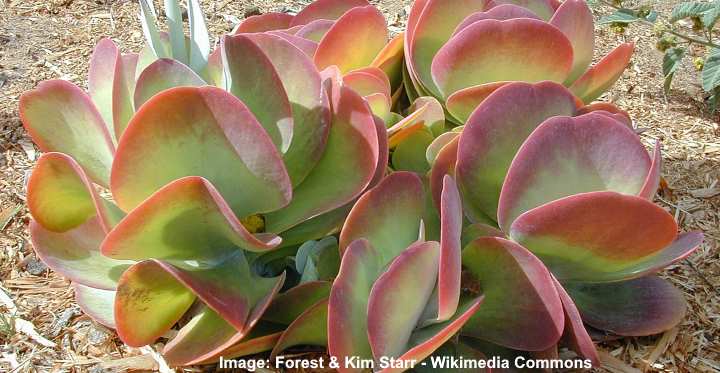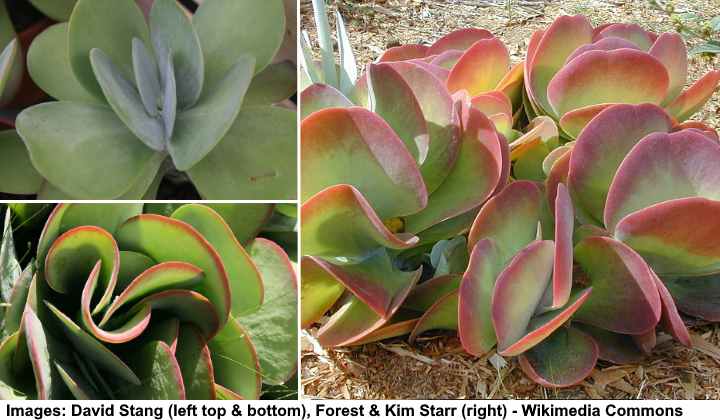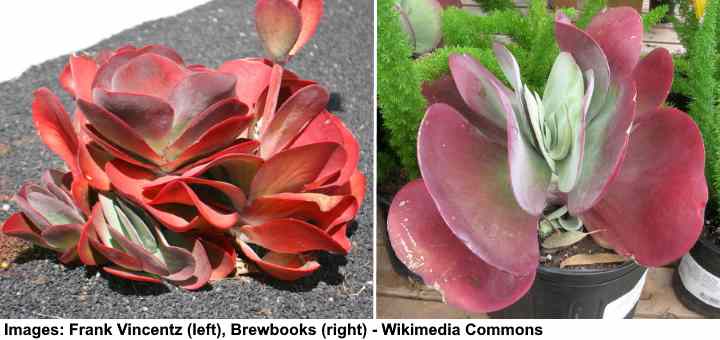Paddle Plant (Kalanchoe thyrsiflora or Kalanchoe luciae): Flapjack Succulent Care (Pictures)

The paddle plant is a pretty, flowering succulent with flat, broad, spoon-shaped jade green leaves with a tinge of red blushing. The large spatulate leaves are the attractive feature of this low-maintenance succulent. Also called the ‘flapjack’ succulent, the paddle plant is easy to look after—all it needs is plenty of light and dry, sandy soil.
There are two varieties of paddle plants that can look remarkably similar. Both belong to the genus Kalanchoe in the succulent family Crassulaceae. However, there are subtle differences between the two succulent varieties—the Kalanchoe thyrsiflora and Kalanchoe luciae.
This article is a complete care guide to growing a paddle plant indoors. You’ll also find out how to tell the two paddle plant varieties apart. At the end of the article, you find helpful tips on resolving issues when growing paddle plants at home.
How to Care for Paddle Plant
To care for a paddle plant, grow the flapjack succulent in bright sunlight, in a warm place, and keep the air relatively dry. The kalanchoe paddle plant grows best in sandy soil that has excellent drainage. Water the succulent only when the soil is dry. Keep in a temperature range between 60°F and 85°F (16°C – 29°C).
Paddle Plant: Kalanchoe luciae vs. Kalanchoe thyrsiflora
The two paddle plant species—the Kalanchoe thyrsiflora and Kalanchoe luciae—are easy to confuse. Both have jade green leaves in the shape of broad flat spoons. Additionally, the succulent leaves have hints of orangey-red hues.
The Kalanchoe thyrsiflora is the species with shorter broad leaves. Compared to the Kalanchoe luciae, its leaves stay mostly green in winter, with only thin red margins around the oval leaves. There is typically a chalky-green coating on this paddle plant which the other one doesn’t have. The Kalanchoe thyrsiflora has urn-shaped yellow flowers with bright yellow petals that give off a strong sweet scent.

Kalanchoe thyrsiflora has green leaves with red margins that are enhanced when the plant is exposed to sun
The Kalanchoe luciae is the more spectacular variety of paddle plants. In winter, and when the plant is stressed, the leaves turn a vibrant red color. Comparing the two paddle plants, you’ll see that the Kalanchoe luciae has tubular flowers with greenish-yellow petals. Additionally, this paddle plant isn’t as heavily scented as the Kalanchoe thyrsiflora.

Kalanchoe luciae has more reddish leaves which are enhanced in cool temperatures
Because both Kalanchoe species are so similar, this article refers to both species when discussing paddle plant care.
Paddle Plant Facts
Kalanchoe luciae and Kalanchoe thyrsiflora belong to a group of evergreen succulents in the family Crassulaceae. Paddle plants have thick, waxy green leaves growing in a rosette shape. The jade-green leaves have attractive hues of red, with Kalanchoe luciae having redder leaves.
Paddle plants grow outdoors, where they thrive in sunny, warm, dry conditions. These heat-loving succulents don’t tolerate the cold and will suffer in temperatures below 60°F (15°C). Paddle plants only grow outside in USDA zones 10 through 12.
Paddle plants get their common name from the broad spoon-shaped, rounded leaves. Other common names for these two Kalanchoe species are ‘flapjacks,’ ‘desert cabbage,’ ‘red pancakes,’ and ‘white lady.’
The paddle plant or flapjack succulent generally grows between 1 and 2 ft. (30 – 60 cm) tall. However, growing in pots, the succulent usually has compact growth and rarely grows taller than 10” (25 cm).
Paddle Plant Flowers

Kalanchoe thyrsiflora flowers
The paddle plant is a flowering succulent that produces tubular flowers on the end of a long stem. The flowers are generally yellow to green in color and bloom in late winter or early spring. Paddle plant flower stems can be up to 3 ft. (1 m) tall.
Kalanchoe thyrsiflora flowers have a sweet fragrance and are more heavily scented than Kalanchoe luciae.
The paddle plant dies after flowering. However, because the plant produces many offsets, the plant will continue to grow from the small ‘baby’ kalanchoes.
It is good to remember that it’s rare for a paddle plant to flower indoors.
Paddle Plant Leaves
Flapjack succulents have attractive wedge-shaped, gray-green leaves with a wide rounded end that tapers toward the plant’s base. Paddle plant leaves are stemless and are described as paddle-like or spoon-shaped. The beautiful fleshy succulent leaves grow as a basal rosette.
The common name ‘flapjacks’ comes from how the rosette leaves are stacked, similar to pancakes. The other name, ‘desert cabbage,’ refers to the cabbage-like shape of some of the rosettes.
Paddle Plant Care Guide
Let’s look in more detail at the best way to grow a paddle plant succulent at home.
How Much Light Does a Paddle Plant Need?
Paddle plants—Kalanchoe luciae and Kalanchoe thyrsiflora—grow best in bright light. The best place to grow a paddle plant is on a sunny windowsill. It’s a good idea to protect the succulent from intense, direct sunlight to prevent leaf scorch during the summer.
During the cool winter months, give paddle plants as much sunlight as possible. Strong sunlight helps to bring out the beautiful red coloring on the Kalanchoe thyrsiflora leaves. You’ll notice that the leaves on Kalanchoe luciae have more intense red colors than the Kalanchoe thyrsiflora.
Paddle plants will also grow in the shade. However, you’ll notice that the succulent foliage loses its red tinges and becomes a pale jade green color. The rounded obovate leaves will also become elongated as the leaves stretch toward the light.
The Best Soil for Paddle Plant Succulents
Like caring for most succulents, a paddle plant must grow in loose, aerated, sandy soil that has excellent drainage. You should ensure that the soil dries out relatively fast between watering. The key to a healthy paddle plant growth is draining holes in the pot to allow water to drain freely.
To create a succulent soil mix for paddle plants, combine two parts of regular potting soil, one part perlite, and one part of coarse horticultural sand. This potting mix allows water to drain super quickly but retains some moisture to keep the succulent roots healthy.
You can also amend the succulent potting mix for desert plants by adding extra sand.
For growing paddle plants indoors, it’s best to grow them in terracotta pots. The porous material allows the soil to dry quicker and helps prevent any issues with excessive soil moisture.
Related reading: Potting soil recipes for any type of houseplant.
How to Water a Paddle Plant
Water a paddle plant succulent whenever the top 2” or 3” (5 – 7.5 cm) of soil is completely dry. During the summer, you may only have to water a flapjack succulent every two weeks. In winter, keep watering to a minimum or don’t water it at all.
Paddle plants are drought-tolerant succulents. So, it’s always better to underwater them instead of watering them too often.
The best tip for watering paddle plants is to let soil dryness dictate when to water the succulent. Although every two weeks is suggested, this is just a general guide. For example, temperature, the type of pot, potting mix, and sunlight can all affect how often to water a paddle plant.
Before watering, poke your finger 2” (5 cm) in the soil. If the potting mix is bone dry, it’s time to water the plant.
Here are some handy tips on watering paddle plant succulents:
- Drench the soil and let the excess water drain every time the soil is dry.
- Always water succulents with filtered, room-temperature water.
- Avoid splashing water on the leaves to prevent fungal issues.
- Never overwater a paddle plant.
The Best Temperature for Growing a Paddle Plant
The paddle plant grows best in temperatures between 65°F and 75°F (18°C – 24°C). However, the heat-loving succulent will still grow well if it’s as low as 60°F (16°C) or as high as 85°F (29°C). The lowest temperature for Kalanchoe plants before leaves get damaged is 30°F (-1°C)
The best thing for Kalanchoe flapjack succulents is that it grows in even room temperatures. So, avoid putting the potted paddle plant in a cold draft, beside an open window, or near a hot air vent. The temperature fluctuations will stress the plant and can cause the fleshy spoon-like leaves to droop or curl.
You can grow paddle plants outdoors if you live in USDA zones 10 through 12. If you live in colder climates, you can grow Kalanchoe plants in pots outside in the summer and bring them indoors when the temperature drops below 60°F (16°C).
Paddle Plant Humidity Needs
To care properly for a paddle plant, keep it in average room humidity below 40 percent. Paddle plants are native to the dry, arid conditions of South Africa. It’s also essential to protect the foliage from dampness and moisture to avoid fungal disease and powdery mildew issues.
How to Fertilize a Paddle Plant
Paddle plants benefit from light fertilization every two months during the growing season. Use a balanced houseplant fertilizer, diluted to half strength. Alternatively, you can use a fertilizer formula for succulents and cactus plants. To ensure the best growth, it’s vital to hold off fertilizing paddle plants during winter.
Paddle Plant Growth Rate
Paddle plants, like many types of succulents, grow faster in warm, sunny conditions. During winter, paddle plant growth slows down, and they stop growing. Their slow growth rate in the winter is a reason to hold off watering and fertilizing during this time.
Flapjack succulents can grow up to 12” (30 cm) tall with a spread of 18” (45 cm).
How to Prune a Paddle Plant
Pruning paddle plants helps remove leggy growth and to propagate using the leaves. A mature paddle plant can also have dense growth that can crowd out the offsets or baby plants. Some plant experts recommend pruning flower stalks to concentrate the plant’s energy in growing the fleshy leaves.
To prune a paddle plant, use sterilized equipment to cut the stems near the soil line. On a stem, you may have several succulent leaves that look like a cabbage rosette. You can then use leaf cuttings to propagate new leaves.
Should you let flapjack succulents flower? Many people consider the tubular Kalanchoe flowers as insignificant and not worth keeping. Snipping off the flower stalk helps keep the succulent’s growth compact. So, cutting the flowers won’t harm the paddle plant and may even speed up growth.
How to Propagate a Paddle Plant
Paddle plant propagation is usually done by leaf cuttings, offsets, or seeds. It’s best to propagate paddle kalanchoe plants in spring or summer.
To propagate by leaf cuttings, cut a few healthy leaves from the mother plant as close to the stem as possible. Place on a paper towel for a few days to allow the wound to heal. Put the cut leaf in a small pot with moist soil for succulent plants. Transfer the tray to a sunny location and keep the soil slightly moist by misting it occasionally.
The easiest way to propagate a paddle plant is by replanting offsets. Look for small miniature plants growing near the plant’s base. Remove them by hand or use a sharp knife. Then place the baby succulent in moist potting soil and put in indirect sunlight.
To grow paddle plants from seed, place the seeds in a moist, porous substrate and cover lightly with soil. Cover the seed tray with plastic and place in dappled light and keep temperatures between 71°F and 76°F (22°C – 25°C). Wait until the kalanchoe seedlings appear before transplanting them to a larger pot.
Repotting a Paddle Plant Growing Indoors
It’s best to repot a paddle plant every one to two years. Transferring the succulent to a larger pot allows more room for growth. At the same time, repotting paddle plants lets you check the roots for damage. You can also remove offsets to propagate new plants.
To repot a paddle plant, carefully remove the plant from its container. Shake off excess dirt from the roots and trim off any dead ones. Choose a new pot that is 2” (5 cm) larger than the current one and half-fill it with a succulent mix. Place the plant in the pot, ensuring it’s growing at the same height as before. Fill in the remaining space and water thoroughly.
Pests Affecting Paddle Plant Growth
Paddle plants rarely succumb to pest infestations if you look after them well. However, sometimes, mealybugs, spider mites, or scale insects can affect plant growth. Use a neem oil solution to spray the leaves and get rid of common household bugs, mites, and pests.
Related reading: How to identify pests on houseplants.
Diseases Affecting Paddle Plant Growth
Root rot and powdery mildew are common plant diseases affecting paddle plants. To avoid fungal disease from affecting Kalanchoe succulents, always water them correctly. This means only watering when the soil is dry and avoiding splashing water on leaves.
Powdery mildew is a fungal disease that looks like white mold on plant leaves. This white powder won’t kill the paddle plant. However, it makes the plant look unsightly. It’s also important to remember that Kalanchoe thyrsiflora has a white substance that naturally grows on the leaves.
Paddle plants affected by root rot have yellow leaves, droopy growth, and may eventually die. To avoid root rot, never overwater the plant. Also, ensure that the soil drains well and dries out between watering.
If you notice signs of rotting roots, it’s best to repot the plant and remove any dead, mushy brown roots. If root rot is extensive, it’s best to take cuttings from healthy leaves to grow a new flapjack paddle plant.
Are Paddle Plants Toxic?
Paddle plants contain toxins that are poisonous to cats and dogs. This jade-colored succulent may not kill a dog or a cat. Still, the ASPCA says that ingesting kalanchoe plant leaves can cause vomiting and diarrhea.
FAQs – Paddle Plant Care
Although flapjack succulents are easy to grow at home, there are a few issues that can affect their growth.
Why are my paddle plant leaves curling?
Watering or light issues are usually to blame for paddle plant leaves starting to curl. Flapjack paddle plants grow best in dry, sandy soil and need to be watered occasionally. Also, the potted succulent should grow in bright light, and some direct sunlight is fine. Try to avoid growing paddle plants in shaded or dark rooms.
What is white powder on a paddle plant?
Paddle plants usually have a light white powder-like coating on their fleshy blue-green leaves. However, if the soil has been damp and the leaves appear discolored with a white powdery coating, the problem could be powdery mildew.
To resolve powdery mildew on succulent plants, wipe the leaves with some diluted milk. Then, only water the succulent soil when it’s dry and keep the paddle plant away from humid rooms.
Why is my paddle plant dying?
Shriveled paddle leaves and drooping growth are usually signs of overwatering a flapjack succulent. Paddle plants don’t like sitting in soggy, overly-damp soil. Excessive soil moisture quickly leads to root rot, and the succulent will start to die.
As soon as you see any signs that your succulent is dying, hold off watering until the soil dries.
Not giving a paddle plant any water at all can also make the leaves wither and die. In this case, drench the soil and allow excess water to drain. Then only water the kalanchoe when the top 2” (5 cm) of the potting mix is dry.
Related articles:
